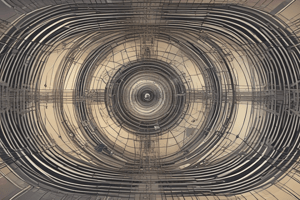Podcast
Questions and Answers
What is the difference between displacement and distance?
What is the difference between displacement and distance?
- Displacement is the total length of path traveled, while distance is the change in position
- Displacement is the total length of path traveled, while distance is the rate of change of position
- Displacement is the change in position, while distance is the total length of path traveled (correct)
- Displacement is the rate of change of position, while distance is the total length of path traveled
What is the definition of velocity?
What is the definition of velocity?
- Rate of change of displacement with respect to time (correct)
- Rate of change of distance with respect to time
- Total length of path traveled divided by time
- Change in position divided by time
What is the equation that relates initial velocity, acceleration, and time to final velocity?
What is the equation that relates initial velocity, acceleration, and time to final velocity?
- v^2 = v0^2 + 2a(x - x0)
- a = Δv / Δt
- x = x0 + v0t + (1/2)at^2
- v = v0 + at (correct)
What is the definition of acceleration?
What is the definition of acceleration?
What is the equation that relates initial velocity, acceleration, and displacement to final velocity?
What is the equation that relates initial velocity, acceleration, and displacement to final velocity?
What are the three key variables used to describe linear motion?
What are the three key variables used to describe linear motion?
Flashcards are hidden until you start studying
Study Notes
Linear Motion
- Linear motion refers to an object moving in a straight line.
- Described by three key variables:
- Displacement (Δx): change in position of an object.
- Distance (d): total length of path traveled by an object.
- Speed (s): rate of change of distance.
Velocity and Acceleration
- Velocity: rate of change of displacement (Δx) with respect to time (t).
- Average velocity: total displacement divided by total time.
- Instantaneous velocity: velocity at a specific instant in time.
- Acceleration: rate of change of velocity with respect to time (t).
- Average acceleration: total change in velocity divided by total time.
- Instantaneous acceleration: acceleration at a specific instant in time.
Kinematic Equations
- Equations of Motion:
- v = v0 + at: relates initial velocity (v0), acceleration (a), and time (t) to final velocity (v).
- x = x0 + v0t + (1/2)at^2: relates initial position (x0), initial velocity (v0), acceleration (a), and time (t) to final position (x).
- v^2 = v0^2 + 2a(x - x0): relates initial velocity (v0), acceleration (a), and displacement (Δx) to final velocity (v).
- These equations can be used to solve problems involving linear motion, velocity, and acceleration.
Linear Motion
- Linear motion is the movement of an object in a straight line, characterized by three key variables: displacement, distance, and speed.
- Displacement (Δx) is the change in position of an object.
- Distance (d) is the total length of the path traveled by an object.
- Speed (s) is the rate of change of distance.
Velocity
- Velocity is the rate of change of displacement (Δx) with respect to time (t).
- Average velocity is the total displacement divided by the total time.
- Instantaneous velocity is the velocity at a specific instant in time.
Acceleration
- Acceleration is the rate of change of velocity with respect to time (t).
- Average acceleration is the total change in velocity divided by the total time.
- Instantaneous acceleration is the acceleration at a specific instant in time.
Kinematic Equations
- The equations of motion describe the relationships between initial velocity, acceleration, and time to final velocity and position.
- The first equation of motion is v = v0 + at, relating initial velocity, acceleration, and time to final velocity.
- The second equation of motion is x = x0 + v0t + (1/2)at^2, relating initial position, initial velocity, acceleration, and time to final position.
- The third equation of motion is v^2 = v0^2 + 2a(x - x0), relating initial velocity, acceleration, and displacement to final velocity.
Studying That Suits You
Use AI to generate personalized quizzes and flashcards to suit your learning preferences.




